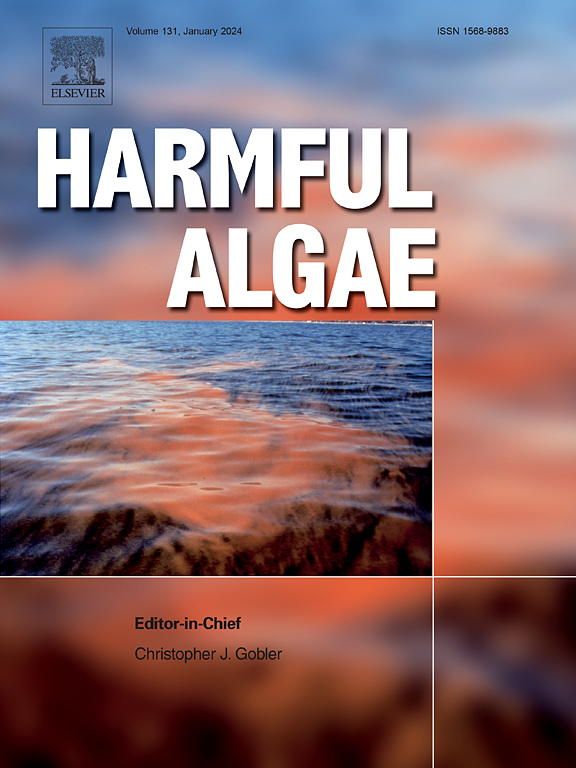波罗的海三个蓝贻贝养殖场生物毒素和潜在有毒浮游植物的季节性动态
IF 4.5
1区 生物学
Q1 MARINE & FRESHWATER BIOLOGY
引用次数: 0
摘要
夏天,在波罗的海蓝藻大量繁殖是很常见的,尽管有几种蓝藻是毒素的制造者,但许多生物仍然将它们作为饲料摄入。这些和其他浮游植物毒素可以在蓝贻贝中检测到,随着季节的积累,这对贝类消费者的健康构成了潜在的危害。因此,在全球范围内,需要在人类食用贝类之前对其体内的生物毒素进行量化。从2022年3月至11月,我们监测了三个蓝贻贝养殖场的11组不同的生物毒素和23种潜在产生毒素的浮游植物分类群的组成。没有一种生物毒素高于现有的健康指标值或管制水平。然而,波罗的海著名的蓝藻毒素结核素是由spumigena结核菌产生的,整个夏季在网养和绳养贻贝中检测到,最高浓度为47µg kg-1。相比之下,较少研究的毒素柱精子素仅在早春和晚秋(地表水温度约为100℃)存在于贻贝中。2-10°C), 4月份最大浓度为19.7µg kg-1,其中aphanizomena是潜在的生产者,但尚未得到证实。此外,在两个地点发现了可能产生腹泻性贝类毒素(DSTs)的尖锐棘齿蛙(Dinophysis acuminata),其L-1含量高达2400只,高于警戒水平,尽管发现的73µg kg-1浓度低于DST组的规定水平(160µg kg-1)。总之,强调高物种丰度并不一定导致高毒素积累。另一方面,贻贝可以有效地作为指示物种,在生产者丰度较低时检测新毒素的存在。由于一年中没有任何时期是完全无毒的,因此建议在收获贻贝时进行定量分析。本文章由计算机程序翻译,如有差异,请以英文原文为准。

Seasonal dynamics of biotoxins and potentially toxic phytoplankton in three Baltic Sea blue mussel farms
Cyanobacterial blooms are common in the Baltic Sea during summer, and even though several cyanobacteria are toxin producers, many organisms still ingest them as feed. These and other phytoplankton toxins can be detected in blue mussels accumulating over the season, which represents a potential health hazard for shellfish consumers. On a global scale, biotoxins therefore need to be quantified in shellfish before human consumption. We monitored 11 different groups of biotoxins in three blue mussel farms and the composition of 23 potentially toxin producing phytoplankton taxa from March to November 2022. None of the biotoxins were above available health guideline values nor regulated levels. However, the well-known cyanobacterial toxin in the Baltic Sea, nodularin, produced by Nodularia spumigena, was detected in net- and rope-farmed mussels throughout the summer, with the highest concentration of 47 µg kg-1. In contrast, the less studied toxin cylindrospermopsin was only present in mussels in early spring and late fall (surface water temperature approx. 2–10 °C), with the maximum concentration of 19.7 µg kg-1 in April, where Aphanizomenon is a potential producer, but yet not confirmed. Further, Dinophysis acuminata, a potential producer of Diarrhetic Shellfish Toxins (DSTs), was observed above warning levels at two sites with up to 2 400 individuals L-1, although the found concentration of 73 µg kg-1 is below the regulated level for DST group (160 µg kg-1). Altogether emphasizing that high species abundance does not necessarily result in a high toxin accumulation. On the other hand, mussels can serve effectively as indicator species, detecting the presence of novel toxins when producer abundance is low. As no period of the year was completely toxin-free, quantitative analysis is recommended when mussels are to be harvested.
求助全文
通过发布文献求助,成功后即可免费获取论文全文。
去求助
来源期刊

Harmful Algae
生物-海洋与淡水生物学
CiteScore
12.50
自引率
15.20%
发文量
122
审稿时长
7.5 months
期刊介绍:
This journal provides a forum to promote knowledge of harmful microalgae and macroalgae, including cyanobacteria, as well as monitoring, management and control of these organisms.
 求助内容:
求助内容: 应助结果提醒方式:
应助结果提醒方式:


